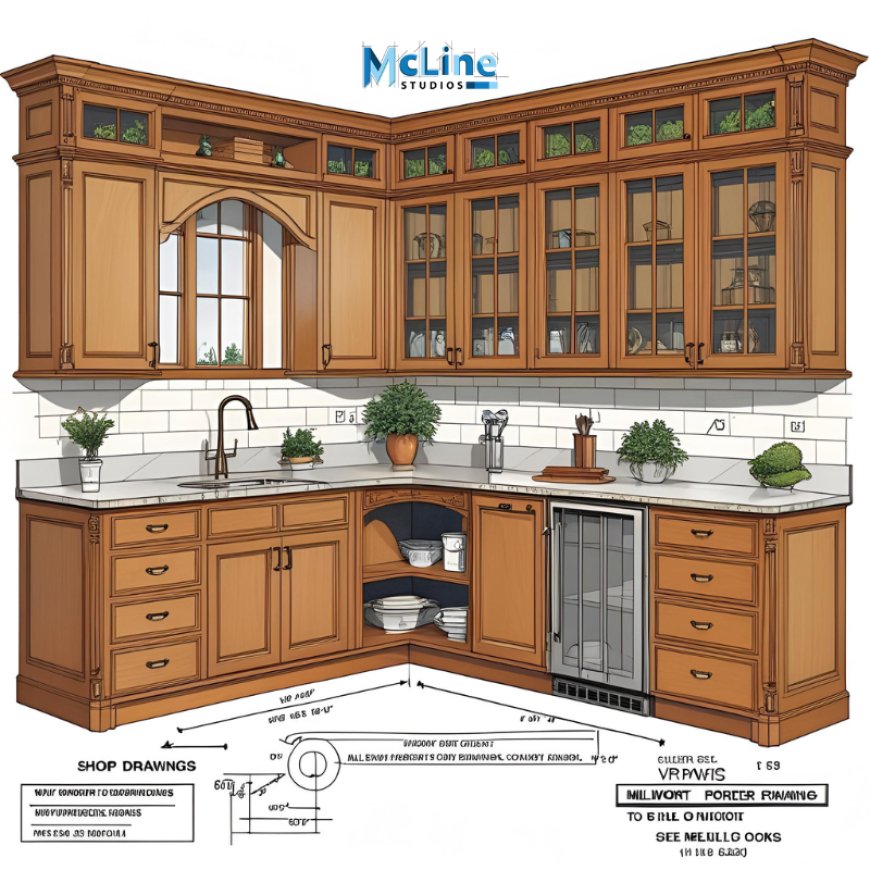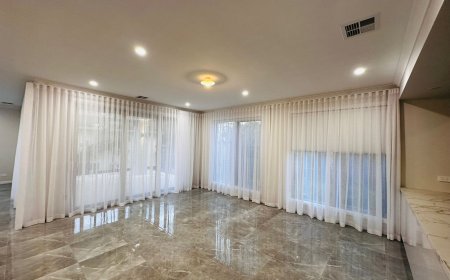Why Millwork Shop Drawings Are Crucial for Commercial Interiors
Millwork refers to custom-made wood products that are built in a workshop and installed on-site. These include cabinets, doors, paneling, molding, shelves, reception desks, and other built-in furniture.

In the dynamic world of commercial interior design, precision and coordination are non-negotiable. From high-end retail stores and corporate offices to restaurants and hotels, the success of a project often hinges on the seamless execution of custom-built elements, particularly millwork.
This is where millwork shop drawings become indispensable. These detailed, scaled drawings serve as the bridge between conceptual design and actual fabrication, ensuring that every trim, cabinet, counter, and panel is built exactly to specification.
More than just technical illustrations, they act as a communication tool between architects, designers, fabricators, and installers, reducing errors, preventing costly rework, and streamlining the construction process.
In this blog, well explore why millwork shop drawings are not just helpful but essential for achieving functional, aesthetically pleasing, and code-compliant commercial interiors.
Understanding Millwork in Commercial Interiors
Millwork refers to custom-made wood products that are built in a workshop and installed on-site. These include cabinets, doors, paneling, molding, shelves, reception desks, and other built-in furniture. In commercial interiorssuch as offices, hotels, restaurants, and retail storesmillwork plays a big role in both the look and function of the space.
Unlike standard furniture, millwork is designed to fit perfectly within a space. It can match the overall style of the interior and serve specific purposes, such as providing storage, guiding customer flow, or creating a warm and professional atmosphere. For example, a reception desk at an office or a display unit in a retail store is often made using custom millwork to meet design needs and space limitations.
Millwork is not just about beauty; it also improves efficiency and user experience. Well-designed millwork can make a space more organized, more accessible, and easier to use. It also helps express a companys brand or identity through materials, finishes, and design details.
Since commercial interiors are used by many people and often face more wear and tear, the millwork used must be strong, safe, and built with high-quality materials. Thats why careful planning and clear communication are needed during the design and construction process.
Understanding millwork is important for anyone involved in building or designing commercial spaces. It helps ensure that every elementbig or smalladds value, serves a purpose, and contributes to a well-designed and functional interior.
Key Reasons Why Shop Drawings Are Crucial
Shop drawings are detailed drawings that show how custom pieceslike cabinets, counters, or wall panelsshould be built and installed. They are very important in commercial interior projects because they turn design ideas into clear instructions for the people who build and install these items. Here are some key reasons why shop drawings are so crucial:
1. Clear Communication:
Shop drawings help everyone involved in the projectdesigners, architects, fabricators, and contractorsunderstand exactly what needs to be done. They show the size, materials, colors, finishes, and installation details clearly.
2. Avoiding Mistakes:
Because shop drawings are checked and approved before any building starts, they help catch errors early. This avoids costly changes or delays later in the project.
3. Accurate Fabrication:
Fabricators use these drawings to cut and build the items with precision. This ensures the millwork pieces fit perfectly in the space and match the design.
4. Better Coordination:
Shop drawings help different teams work together smoothly. For example, the carpenter, electrician, and plumber can use them to plan their tasks without conflict.
5. Time and Cost Saving:
With detailed shop drawings, the project moves faster and stays within budget because everyone knows what to do and when to do it.
In short, shop drawings are not just technical documentsthey are the roadmap for building custom interiors correctly and efficiently. Without them, even the best designs can run into problems during construction.
How to Ensure High-Quality Shop Drawings
High-quality shop drawings are key to successful commercial interior projects. They help make sure everything is built right, fits well, and looks good. Here are some simple ways to ensure your shop drawings are accurate and high-quality:
1. Start with Clear Design Plans:
Before creating shop drawings, make sure the design plans are complete and approved. The better the design, the easier it is to create shop drawings that match the vision.
2. Use the Right Software:
Using professional drafting tools like AutoCAD or Revit helps create precise and clean drawings. These tools allow for detailed measurements, layers, and 3D views if needed.
3. Include All Key Details:
A good shop drawing shows every important detailmeasurements, materials, finishes, hardware, joinery, and installation methods. This leaves no room for confusion.
4. Follow Industry Standards:
Shop drawings should follow industry drafting standards. This includes using proper line types, symbols, and scales to make the drawing easy to read for all team members.
5. Double-Check Everything:
Always review and check the drawings for accuracy. Mistakes in size, material, or layout can lead to delays and extra costs.
6. Get Approval Before Fabrication:
Make sure the architect, designer, or client reviews and approves the shop drawings before any building begins. This step avoids misunderstandings later.
By paying attention to these steps, you can ensure your shop drawings are clear, correct, and ready to guide smooth fabrication and installation.
Challenges Without Shop Drawings
Shop drawings are like detailed maps that guide builders and installers in a commercial interior project. Without them, many problems can arise during construction. Here are some key challenges that happen when shop drawings are missing or not used properly:
1. Miscommunication:
Without shop drawings, its hard for architects, designers, fabricators, and contractors to stay on the same page. Each team may have a different idea of what needs to be built, leading to confusion and mistakes.
2. Wrong Measurements:
Shop drawings provide exact dimensions for each custom piece. Without them, parts like cabinets or panels may not fit properly, which causes delays and extra costs to fix the issues.
3. Poor Work Quality:
Detailed drawings show how parts should be made and what materials to use. Without these, the finished product may not match the original design or meet the quality standards.
4. Increased Costs:
Mistakes due to lack of clear drawings can lead to rework, wasted materials, and more labor timeall of which increase the overall project cost.
5. Delays in Project Timeline:
When problems appear during installation, teams have to stop and figure things out. This slows down the work and can delay the projects completion.
6. Difficult Approvals:
Clients and architects need to approve shop drawings before building starts. Without them, getting final approvals becomes difficult and risky.
In short, not using shop drawings can lead to poor results, wasted time, and higher costs. They are essential for smooth and successful project execution.
Our Thoughts
Millwork shop drawings are the foundation of a successful commercial interior project. They ensure that every custom elementwhether its a reception desk, wall panel, or storage cabinet is built exactly as planned. From improving communication and reducing errors to saving time and money, shop drawings play a key role in bringing design ideas to life with accuracy and efficiency.
Without these detailed drawings, projects are more likely to face delays, costly rework, and miscommunication between teams. On the other hand, high-quality, well-reviewed shop drawings lead to smoother workflows, better coordination, and professional results that meet both aesthetic and functional goals.
In commercial interiors, where space planning, brand image, and durability are vital, millwork must be designed and built with care. Shop drawings make that possible. By understanding their value and ensuring their quality, design, and construction teams can deliver interiors that look great, work well, and stand the test of time.








































